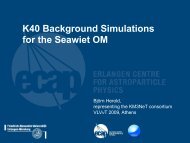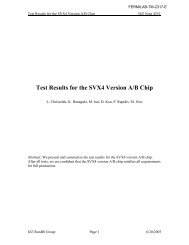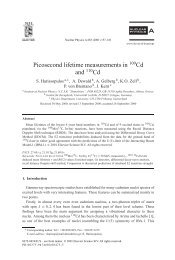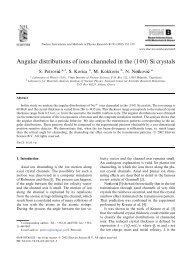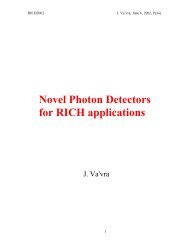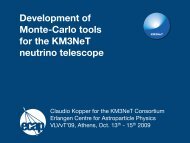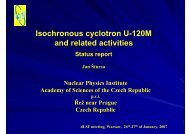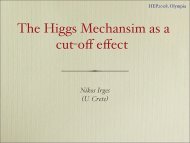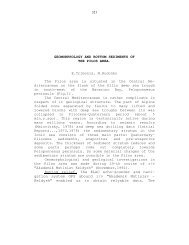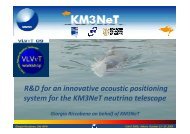"Operation and performance of the NESTOR test detector" Nucl.Instr ...
"Operation and performance of the NESTOR test detector" Nucl.Instr ...
"Operation and performance of the NESTOR test detector" Nucl.Instr ...
Create successful ePaper yourself
Turn your PDF publications into a flip-book with our unique Google optimized e-Paper software.
ARTICLE IN PRESS<br />
G. Aggouras et al. / <strong>Nucl</strong>ear <strong>Instr</strong>uments <strong>and</strong> Methods in Physics Research A 552 (2005) 420–439 433<br />
Fig. 11. The total number <strong>of</strong> accumulated photoelectrons inside <strong>the</strong> trigger window during bioluminescence activity (crosses) <strong>and</strong> with<br />
no bioluminescence (histogram).<br />
Fig. 12. Trigger rates as a function <strong>of</strong> <strong>the</strong> coincidence level, for<br />
two threshold settings. The points represent <strong>the</strong> data, <strong>the</strong> solid<br />
line <strong>the</strong> Monte Carlo estimation including background <strong>and</strong> <strong>the</strong><br />
dashed line <strong>the</strong> Monte Carlo estimation for <strong>the</strong> contribution <strong>of</strong><br />
<strong>the</strong> atmospheric muons.<br />
At <strong>the</strong> end <strong>of</strong> <strong>the</strong> active experimental window<br />
<strong>the</strong>re is a small peak in <strong>the</strong> data that does not<br />
appear in <strong>the</strong> Monte Carlo expectation. This is due<br />
to a known malfunction in <strong>the</strong> first generation <strong>of</strong><br />
ATWDs, which digitize a low amplitude ghost<br />
Fig. 13. Total number <strong>of</strong> photoelectrons inside <strong>the</strong> coincidence<br />
window as a function <strong>of</strong> <strong>the</strong> coincidence level for two threshold<br />
settings. The points represent <strong>the</strong> data <strong>and</strong> <strong>the</strong> histogram gives<br />
<strong>the</strong> Monte Carlo estimation. The errors are calculated from<br />
event statistics <strong>and</strong> not from <strong>the</strong> number <strong>of</strong> <strong>the</strong> photoelectrons.<br />
The number <strong>of</strong> photoelectrons is <strong>the</strong> mean number collected<br />
inside <strong>the</strong> coincidence window per trigger.<br />
pulse at <strong>the</strong> end <strong>of</strong> <strong>the</strong>ir active window. This<br />
problem does not affect <strong>the</strong> analysis because only<br />
pulses inside <strong>the</strong> trigger window are used.



